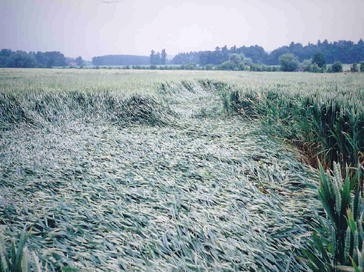Plants have evolved to grow vertically – to reach more sunlight – and horizontally – to increase their surface area and capture more sunlight. However, vertical growth is almost always undesirable because of the many problems it can generate. With this article I am starting a series of posts about “keeping plants short” which will cover a lot of the practical methods that have been developed in order to stop and modulate the vertical growth of plants. In this first post I want to look at the reasons why keeping plants short is desirable in almost all plant species and growing conditions and give you some hints about the methods that I will be discussing in future posts about the practical actions we can take to keep our plants small, yet highly productive. So why is it important to keep plants short?

Lodging prevention. Mechanical stability is very important when growing plants. Tall plants are mechanically less stable because the upper parts of the plant can apply a lot of leverage to the base of the plant. If enough weight is accumulated and force is applied – through wind for example – the plant can easily break or the stem be displaced for the vertical position, leading to huge losses in the crop. Plants that are shorter are naturally more resistant to lodging because there is less mechanical advantage to apply leverage on the base of the plant, the plant is therefore less likely to move from its vertical position, even if some force is applied.
Ease of harvesting. The taller a crop, the more inconvenient it is to harvest the product. For fruiting crops it becomes more inconvenient to pick fruits from higher positions while for crops like potatoes more material from above the ground needs to be removed. This difficulty to harvest the fruits is the main reason why some perennial crops, like African palm, become unproductive. At some point in time the fruits are so far up that it is no longer feasible to mechanically harvest them. In hydroponic crops like tomatoes the height of the plant is limited by the mechanical constraints of the greenhouse, if a plant is shorter and more trusses per meter can be grown, then this immediately leads to an increase in potential productivity.

Ease of transport. When a plant is shorter, the movement of nutrients and water from the roots to the leaves is easier, as the distance is smaller. Plants that are shorter need to fight gravity less and will therefore be able to transport nutrients more efficiently to their fruiting bodies. This is why the first flowers of all plants are usually the most productive – because they are the closest to the root system – and why the further away you go from the ground the smaller and smaller the fruits tend to become. Having short crops means that the top fruits and flowers will receive a higher degree of nutrition than they would if the crop was taller.
More homogeneity. Related with the above, when plants are shorter the distribution of nutrients among the plant is better because leaves, flowers and roots are all in closer proximity. Taller plants with larger inter-nodal distances will tend to have more distance between leaves and fruits, which will decrease homogeneity as the difference in light irradiation and root-to-leave transport between the nodes will be greater. A plant with the same number of leaves and flowers with lower inter-nodal distances will have much more homogeneous products for this reason.
The above are some of the most important reasons why it is usually desirable to have plants that are short. However, we do not want plants that are just short, but we want plants that are short but preserve the same yield as taller plants. This means we must get creative and use solutions that can manipulate the plants to give us the best of both worlds. There are a potential array of solutions to this problem. For example we can attempt to directly interfere with the chemistry of stem elongation (synthetic gibberellin inhibitors), to indirectly interfere with the chemistry by trying to stimulate other processes, to do genetic selection of plants that are naturally shorter, to provide mechanical stimulation to prevent elongation, to change light characteristics to inhibit elongation or to use day/night manipulations to achieve this same goal. We will explore many of these potential solutions within subsequent posts.




